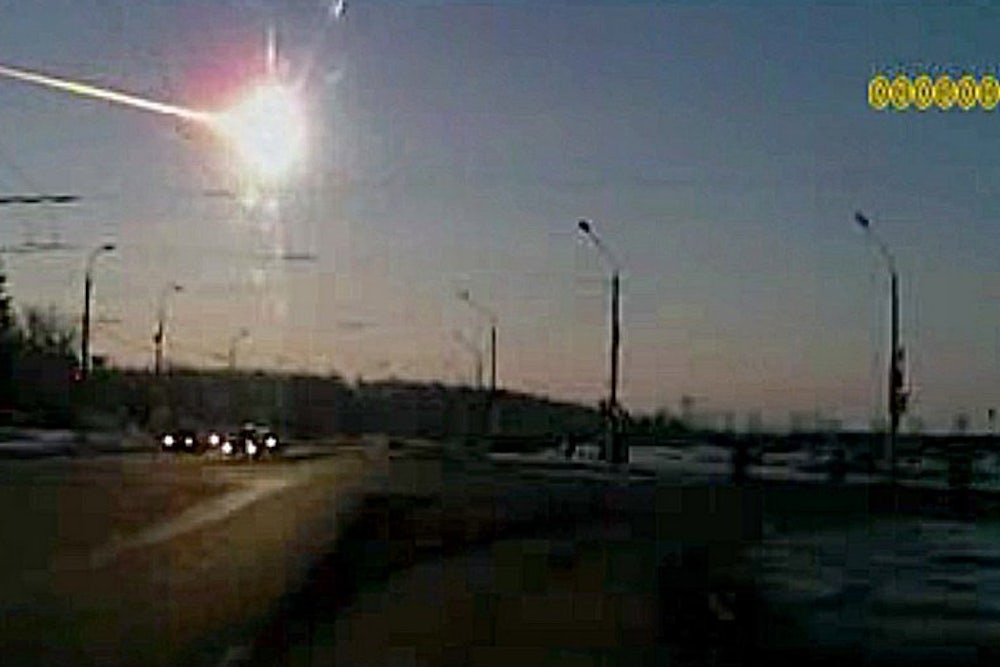The explosion of a large meteor over a medium-sized city would have been worldwide news at any time in the modern era, but something peculiar to this historical moment made the Chelyabinsk blast a global sensation. Friday's event marked the first time that a large meteor fall has been filmed by hundreds of cameras. This was accomplished spectacularly, thanks to the sudden ubiquity of small videocameras and video-equipped cellphones, and the Russian fad for dashboard-mounted cameras. The cameras recorded from every direction the meteor's descent over the city, as well as the effects of its sonic boom, the reactions of the witnesses, and, just as the meteor approached, the elements of life in a typical Siberian city on an ordinary workday morning. In my favorite clip, the fireball illuminates a busy roadway, and we're given a taste of the aggressive Russian driving style, as well as a sampling of Chelyabinsk's drive-time music, which in this case a friend has identified as "Bleeding Love" by the British pop singer Leona Lewis.
The rich, timestamped video record makes it easy to confirm the unusual, astonishing, ephemeral phenomenon, where and when it occurred, and track where debris from the object landed.
The Chelyabinsk event also suggests that, thanks to the small videocamera that has become almost as common an accessory as a wristwatch, another reputed sky phenomenon is now subject to confirmation or complete debunking: UFOs. Every several years there's a significant news report of mysterious objects in the sky, hovering overhead, usually sworn to by multiple witnesses and sometimes captured in a single grainy photographic image or shaky film shot. According to a survey by National Geographic, more than one-third of the American public believes that these phenomena represent sightings of extraterrestrial spacecraft. The scientific community considers the evidence unpersuasive, and rules out the faster-than-light travel that would make interstellar journeys feasible, but the persistence of the reports rattles around the framework of astronomical science like a loose part.
Many astronomers believe that with the ingredients of life—water and hydrocarbons—prevalent throughout space, and planets enough, extraterrestrial life is possible and very much worth looking for. I learned just how hot this pursuit is a few years ago, when I went to Paris for a four-day symposium dedicated to the search for extraterrestrial intelligence, sponsored by the International Academy of Astronautics. Planets around other stars are being discovered every week. New techniques are being developed to inspect their atmospheres for the products of respiration and other life processes. Giant arrays of radio telescopes around the world listen for signals from advanced civilizations. The astronomers reviewed the new research with anticipation and excitement, but some audibly worried about why no alien life has yet been found in a universe potentially teeming with life. As good scientists, they wondered if there was something obvious they were missing in all their hard-won data.
Yes, the UFO enthusiasts would say, with rising exasperation. Some of them had come to Paris. In the spirit of open-mindedness, the conference organizers accepted a paper whose low-key title, "Investigation and analysis of transient luminous phenomena in the low atmosphere of Hessdalen valley, Norway," belied its sensational claims, which were that the strange, moving lights occasionally witnessed in the valley's thick nighttime mists belonged to alien spacecraft. A video showed the lights. The astronomers attended in polite silence, some eyes were rolled, and then afterwards, among themselves, they easily dismissed the phenomena, either as natural events or human-piloted aircraft.
But what if there were dozens or hundreds of small cameras ranged across the valley at the time of the sightings? Or if they were at the ready in Wales in 2008, when a police helicopter encountered a mysterious flying object above an RAF base? Or in Michigan in 1966, when hundreds of people said they witnessed the maneuvers of a large, airborne football-shaped object? The videos would have either solidly confirmed the presence of alien spacecraft in our skies—another triumph for crowd-sourced science—or they would have shown that more mundane processes were at work. Now that the handheld videocamera is everywhere, the next significant UFO sighting should be captured by numerous independent observers like those in Chelyabinsk, some of them simply driving by in their cars, listening to Leona Lewis.
Any alleged UFO sighting not captured by numerous cellphone and videocameras should not be worth reporting. As multiple film clips become the standard record for unusual public phenomena, we may see a precipitous fall-off in claims of alien visitations. The UFO hypothesis will be put to rest. The presence of extraterrestrials somewhere in the universe will still be an open issue, but if they exist, they will have to live far beyond our earth. Then the only visitors we can ever expect to drop in from space will be rocks—fast-moving, exploding, window-shattering, and, sadly, utterly lifeless.
